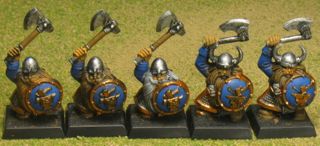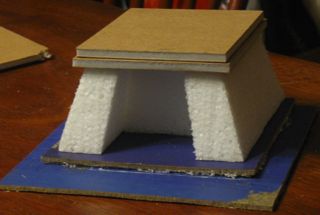Devlan Mud is Dead! Long Live Devlan Mud!
Games Workshop’s Devlan Mud wash has been a commonly used weapon in my painting arsenal since I got back into painting miniatures 3 years ago. It works well straight out of the bottle, and produces reasonable results in areas where I’m not that interested in painting in highlights and shadows, but when I also don’t want to dip the whole figure.
Unfortuantely, Devlan Mud is no longer available, since Games Workshop recently completely revamped their paint line. When I was at Legions for Stoogecon, I picked up 3 possible replacements to try out:
- Games Workshop’s Agrax Earthshade wash, which seems to be their replacement for Devlan Mud
- Army Painter Dark Tone Ink (not the Quickshade dip)
- Reaper Master Series Paints Brown Wash
I meant to get Army Painter’s Strong Tone Ink for a better direct comparison with the Quickshade. Oops! That will have to wait for now.
I was painting a DBA Early Egyptian army, so on one stick of archers, I painted all of the figures identically but applied different washes to each. On another stick, I used Army Painter Strong Tone Quickshade. These figures are almost entirely flesh and white. I liked this for comparison purposes because white is notoriously difficult to shade well, and it doesn’t disguise the color of the ink wash at all.
I also used these inks and washes that I had on hand for more comparison:
- Didi’s Magic Ink, Brown
- Games Workshop Gryphone Sepia wash
- Games Workshop Ogryn Flesh wash
- An old Reaper flesh ink with water added
Here is a comparison shot detailing the results.
 |
| Ink Wasy Comparison: Essex Early Egyptians. Army Painter Strong Quickshade on top, washes below. |
And here are the results, left to right.
First, a comparison between Devlan Mud and Agrax Earthshade. I think Devlan Mud is a bit less red/orange than Agrax Earthshade, but they’re both very neutral. My Devlan Mud was old, and probably doesn’t work as well as it did when it was new, but the Agrax is doing a better job of staying in the cracks and not coloring the high spots and flat surfaces as much. As seen on the red feathers, the overall tone of the Agrax-shaded figure is lighter than the Devlan-shaded figure.
Agrax Earthshade is also a much better direct replacement for the Army Painter Strong Tone Quickshade dip. Overall, if it were my only choice, I’d be happy to replace Devlan Mud with Agrax.
Unfortunately, some of Devlan Mud’s flaws are still apparent in Agrax Earthshade. It still smells like a combination of distilled bong water and moldy coffee grounds. It’s still really expensive and comes in tiny bottles that let the liquid evaporate too much. I’ve also found that all of the GW washes behave badly if they either dry out, or if you add water or just about anything else to them to thin them out. This shortens their effective shelf life even further.
The new bottles prevent your local store’s in-house painters from using the wash and then putting it back on the shelf, but I didn’t find the new “keep your lid open” feature any better than their previous attempt several bottle designs ago.
Army Painter’s Dark Tone Ink seems to work as well as their Quickshade does, but I bought the wrong color so I can’t effectively compare colors with the Agrax.
The Reaper Brown Wash seems closer to the old Reaper inks than to GW’s washes. It looks more opaque in the bottle, and doesn’t stay in the cracks as well as the other modern Wash products do.
I’ve been using Didi’s Magic Ink for almost as long as the GW washes. It has two major benefits over the GW products: it comes in much larger, less expensive dropper bottles, and it smells nice. Brown is a very good direct replacement for GW’s Gryphone Sepia, but it’s too light to replace Devlan/Agrax. Didi’s ink is much thinner than the GW washes, more of the consistency of water. It stays in the cracks well, but it is hard to get it to darken things as much as you might like to.
Games Workshop’s Gryphone Sepia and Ogryn Flesh wash are also no longer available in GW’s new paint line. They work just like Devlan Mud and Agrax Earthshade, but they’re different colors. I would be interested in testing their new replacement versions, but I haven’t had a chance to do this yet, and I might not since I don’t run out of these colors as quickly.
The old Reaper Flesh Ink is not a modern wash. My bottle is probably about 10 years old, and may not be available anymore, I’m not sure. It requires thinning with water and your favorite additives to flow properly and fill in the cracks. Here, I applied it using only water to thin it out, and it worked fairly well. However, at this point I wouldn’t bother using this product unless I was doing something like airbrushing.
Overall, Agrax Earthshade is the clear winner of this exercise, with one caveat. If Army Painter Strong Tone Ink works as well as the Dark Tone, I would probably prefer it due to its superior dropper bottle and price point.
I hope this helps someone else in the market for a replacement for their precious supply of Devlan Mud. In the future, I’ll try to do some more comparisons including Army Painter Strong Tone, as well as various black/almost-black washes.



















